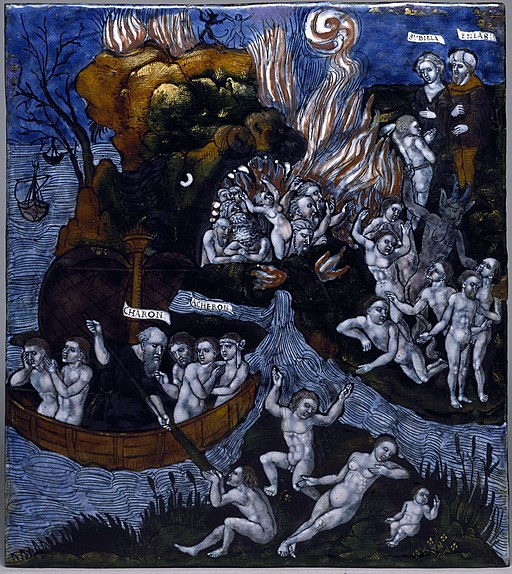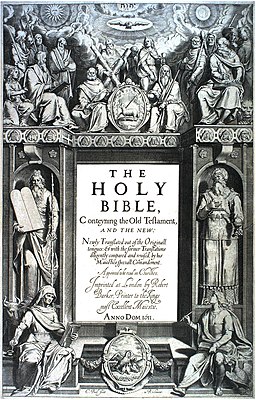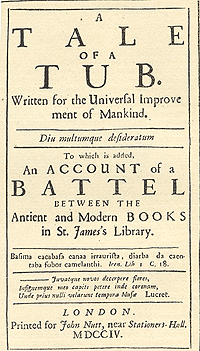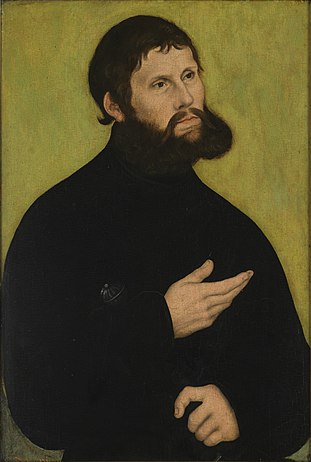This essay is the first of two distilled from a lecture series on Jonathan Swift given by Dr. Abigail Williams of the University of Oxford and adapted for the Great Writers Inspire Project by Kate O'Connor.
Jonathan Swift's Tale of the Tub is a brilliant failure. It is a prose satire intended as a defence of the Anglican church, but it was widely interpreted by contemporary readers as an attack on all religion. At the time of writing it, Swift was a junior Anglican clergyman hoping for substantial preferment in the Church. The appearance of the Tale, and its assumed message, was a serious obstacle to his promotion.
One of the things that makes the Tale difficult to interpret for that the work attacks multiple things of things at the same time: it's an allegory about religious differences; it's a satire on pedantry and false scholarship; it's a parody of the contemporary book trade; it has attached to it two further treatises, the 'Battle of the Books', and the 'Mechanical Operation of the Spirit'. This essay will examine notions of authorship, intertextuality, originality, and the relationship between parody and allegory, and try to determine how all these components fit together.
The Title and Structure
The first thing that's puzzling about A Tale of A Tub is its title. The preface explains that it is the practice of seamen when they meet a whale to throw out an empty tub to divert it from attacking their ship. The whale that this tub is thrown out for most obviously represents Thomas Hobbes's Leviathan. Swift's tub is intended to distract Hobbes and other critics of the church and government from picking holes in their weak points.
The Tale, with its two appendages ('The Battle of the Books' and 'The Discourse Concerning the Mechanical Operation of the Spirit') is Swift's first important prose work. It was written during the 1690s, when Swift was living with his patron Sir William Temple, and it was published in 1704. Most modern scholars read the revised fifth edition published in 1710. Like Swift's other major prose - including Gulliver's Travelsand A Modest Proposal - A Tale of a Tub was published anonymously. But unlike with those later works, Swift was obsessively concerned with preserving the anonymity of his authorship of the Tale. His authorship of the Tale was never publicly acknowledged in his lifetime, nor did it appear in authorised editions of his collected works.
But although Swift vigorously maintained the fiction of anonymity in relation to A Tale of a Tub, never at any point did he try to suppress the book as a whole; he only tried to obscure his direct connection with it. But despite the fact that he was desperate that no one should ever know that he wrote A Tale of a Tub, he also seems to have been extraordinarily proud of his satire. The one comment that we have on record from Swift about the Tale comes from a letter transcribed for the Earl of Orrery:
'There is no doubt but that he was Author of the Tale of the Tub. He never
owned it: but as he one day made his Relation Mrs Whiteway read it to him,
he made use of This expression. 'Good God! What a flow of imagination had
I, when I wrote this.'
There is a strange paradox here: Swift wanted to disavow his connection with the work, yet at the same time he wanted the genius evident in the satire to be recognised as his.
Religious Orthodoxy
Swift says in the 'Apology' that was added to the 1710 edition that A Tale of a Tub was partly intended to attack the religious groups that he saw as threatening the hegemony of the Anglican church. In the Tale, Swift uses the analogy of the three brothers - Martin, Peter and Jack - to represent, respectively, the Anglican Church, the Catholic Church, and the Low Church, or Dissenters. In doing so, he is trying to demonstrate that the spiritual practices of the Catholic Church and dissenting sects were based on a false interpretation of the true Word, the Bible. However, the sweep of Swift's irony in the book, and, the destabilising and confusing nature of its changes in satiric personae meant that many of his contemporaries read the Tale as an attack all religion.
For a young Anglican churchman intent on a speedy ascension through the ranks of the church, this was a very damaging charge. Swift's decision to publish the apology in the revised edition of 1710 likely is related to his anxiety about his career at this time, and the Tale's potential to compromise his position. Late 1710, was perhaps the most exciting and promising time in Swift's career; he was being courted by the rising Tory leader Robert Harley to join the Tory cause, and power and importance seemed imminent. Swift was to believe for the rest of his life that his failure to secure the ecclesiastical promotions that he wanted was due to influential (including royal) disapproval of the perceived irreligious tendencies of A Tale of a Tub.
Authorship and Identity
But there may be more to Swift's desire to remain guarded about his authorship of A Tale of a Tub than just its potential to compromise his rise to power. Swift seems to be ambivalent about his ownership of the work not just in the original text of 1704, but also in the 'Apology' added in 1710. The 'Apology' is a very strange document: it purports to be a straightforward clearing up of unnecessary misunderstandings, but it actually fails to clear anything up at all.
It is supposed to be an intervention in the controversy over the intended meaning of the Tale. However, the author of the 'Apology' does not admit to being Swift, or even the author of the Tale. Swift creates a third person figure that seems to ventriloquise a defence of the work that is part on behalf of an enraged and violated author, and part an outsider coming to his rescue. The apology refers consistently to the author, saying that 'the author cannot conclude this apology without…' or 'the author observes'. But the tale is complicated by the Apology's use of an 'I' in it, a figure that is differentiated from 'the author'.
What then is the authority of the 'Apology'? Whose is this intervention? Does it matter if we do not know? Does it make a difference to the way we read the text if it is prefaced with a foreword by the author, as opposed to someone else? And once we get into the argument of the 'Apology' itself, there seem to be rather contradictory arguments at work about the role of the author. On one hand, the speaker inveighs against all those who have sought to identify Swift as the composer of the parody:
'He thinks it no fair proceeding, that any Person should offer determinately
to fix a name upon the Author of this Discourse, who hath all along
concealed himself from most of his nearest Friends.'
However, further on, he seems to assert the originality of the work, and suggests that there is only one original genius that could have composed a work of such verve and erudition. Taking issue both his critics' charges that he had plagiarised the work, and with the fact that a man called Thomas Swift had recently claimed to have written the Tale, the apology asserts:
'It indeed touches the Author in a very tender Point, who insists upon it,
that through the whole Book he has not borrowed one single Hint from any
Writer in the World; and he thought of all Criticisms, that would never have
been one. He conceived it was never disputed to be an Original, whatever
Faults it might have'.
What we seem to have here is the desire to disown the text, to disown
responsibility for it, to suggest that a book's authorship is irrelevant.
But we also see the urge to lay claim to it, on the grounds of some notion
of original genius.
Originality
The idea of originality is vexed by A Tale of a Tub. As we've seen here, Swift both dismisses the importance of authorship and fiercely defends it. These ambiguous and contradictory concerns are is mirrored within the text, which in some ways it seems to push the boundaries of what can be called an original. A Tale of a Tub is profoundly postmodern in its intertextuality, its play with literary forms, and its changes in speaker and genre and that constantly undermine readerly expectations of the text. It parodies bookseller's catalogues, scholarly treatises, scientific works, effusive dedicatory prose, and it borrows, magpie-like, from a wide and disparate range of sources. A Tale of a Tub is a patchwork of unattributed quotations to Dryden, Marvell, Richard Bentley, Thomas Browne, and Joseph Addison.
After the Tale appeared in 1704, William Wotton, an Anglican clergyman incensed by what he saw as Swift's impropriety, published a critique of the work. It was entitled Defense of the Reflections upon Ancient and Modern Learning, With Observations upon The Tale of a Tub(1705). In the critique, Wotton offered an explication of the story of the three brothers, attempting to demonstrate that the Tale was a work of radical impiety. When Swift brought out his revised 5th edition in 1710, he cheekily copied the explanatory material of Wotton's attack and had them printed as notes to the new edition his own text. Thus, from 1710, part of the Tale was made up chunks of Wotton's attack on it, cut and pasted in as the Tale's textual apparatus. So in one sense, since it derived so many bits and pieces from other authors, none of the Tale is original. Yet on the other hand, Swift used these other works to compose a wholly new text, one he asserted roundly in the apology was 'an Original, whatever its Faults might have been' and which he later declared was the product of a magnificent 'flow of the Imagination'.
These ideas about originality are reflected in the Tale's relationship to one of its major influences. The text that the Tale most explicitly situates itself in relation to is one that also poses problems of classification as 'original work': John Dryden's Translation of the Works of Virgil in English, of 1697. Dryden's Virgil was the big publishing sensation of the decade. The former laureate issued his definitive version of the great Latin's epic poems, and Dryden's Virgil remained the standard edition until well into the twentieth century.
Swift's A Tale of a Tub was composed at the same time that the Virgil was printed, and in A Tale, Swift takes it upon himself to attack Dryden's work. Swift represents Dryden as a midget cowering in gigantic Virgilian armour, an author who represents the worst of modern literary narcissism. Dryden's extraordinary multiplication of prefaces, dedications, and illustrations offer a model for the external structure of A Tale, which parodies these excesses by incorporating an unfeasible amount of prefatory material before we ever get to the main text: Swift's Tale has an 'Epistle Dedicatory to Prince Posterity', followed by a preface, and then an introduction.
So when Swift snidely suggests that any 'very Considerable Addition to the Bulk of the Volume' is 'a Circumstance by no means to be neglected by a Skilful writer,' he is taking a swipe at Dryden. But Dryden's Virgil is also very interesting in relation to the idea of originality, and plagiarism; like all translation, it is at once a version of an older text, and a new work in its own right. To whom did the lines of the Aeneid belong? Dryden or Virgil? To complicate matters, in producing his edition, Dryden stole words and phrases on a large scale from previous translators, particularly Lauderdale. And to turn this same scrutiny upon Jonathan Swift, is A Tale of Tub is actually an enormous compilation of quotation claiming inspired originality?

The Ancients and Moderns
How do Swift's concerns about originality and authorship reflect on contemporary cultural debate? 'The Battle of the Books', along with the Tale, was perhaps the most impressive English contribution to the so-called quarrel of the Ancients and the moderns. The history of this quarrel can be traced back to the Renaissance. Rediscovery and publication of the philosophers and poets of ancient Greece and Rome generated a huge sense of intellectual and cultural liberation for many sixteenth century writers. But with this revival came a questioning of assumptions about the value of the classical texts.
In literary terms, the debate polarised around the question of whether present civilisations could hope to outdo the achievements of the ancient world in the arts, and in science and technology. Some contemporaries, 'the Moderns', were excited by this possibility. There were moderns who were classical scholars, like Richard Bentley (who is satirised in 'Battle of the Books'), who believed that there was nothing sacred about classical texts. He believed that the classical past should be seen as a body of material that could be dated and analysed, and above all historicized. The classics were not a body of transcendent truths for all time, but an historical source about a much less advanced classical past. So he produced editions of classical texts with endless footnotes and appendices re-contextualising and analysing the poetry in terms of this historical past, not unlike modern critical editions of the works of Shakespeare.
But 'the Ancients', among whose number Swift counted himself, realised with horror that aspirations of this kind threatened the educational and cultural structures that Europe's elite had shared ever since the Renaissance rediscovery of the classical past. Educated in a humanist tradition of scholarship, 'the Ancients' believed that the values derived from Greek and Roman literature continued to provide authoritative standards of virtue, rationality, and aesthetic taste. The classics weren't remnants of a past and primitive culture: they were culture, and were cornerstones by which all human endeavour could be measured. They were not to be questioned or dissected by scholarship in the way Bentley attempted.
Swift was tied in to this debate heavily because his patron at the time of writing the Tale, Sir William Temple, was a key figure among the group of Ancients. Swift's 'Battle of the Books' engages fully on the side of the Ancients: through the figure of Scaliger, Swift attacks Bentley for his lack of grace, observing the irony that the classics have failed to infuse their decorum and civilising influence on the scholar. Swift writes, "All Arts of civilising Others, render thee rude and untractable." The social and cultural superiority of the Ancients is reflected in their imperviousness to the assaults of the moderns, and this is illustrated in the mock-epic passage near the end of the 'Battle of the Books', where the Anglican churchman and modern defender of Bentley, William Wotton, hurls a lance at William Temple but we are told that Temple "neither felt the Weapon touch him, nor heard it fall".
This debate about ancient and modern learning is clearly intimately bound up with the interrogation of authority and authorial status that we see in A Tale of a Tub. The Ancients and Moderns debate was in essence about a question of origins, and of textual authority. It was about how far the authority of the classical poets extended. If you took the Ancients argument to its logical conclusion, no truly newgreat literature could ever be produced, because the summit had already been achieved. The best that was left was imitation. And so you could read the tissue of allusions and borrowings that constitutes the Tale as a trope for the indebtedness of modern literature, for its dependence upon earlier texts that render the idea of modern originality meaningless. And in formulating a brilliant work out of a collage of older ones the tale, Swift gestures toward the way in which the ancients can continue to generate new and imaginative literature: the habits of allusion and imitation that were at the centre of the neoclassicism of the Ancients could also be generative.
The Tale is self-consciously digressive, and attacks the modern writers unmindful of the past and obsessed with the idea of being up to the moment. The narrator of the Tale is fatuously scrupulous in recording this contemporaneity by recording the most trivial domestic circumstances and everything that enters his head at the moment of writing, including his thoughts on the writing of his thoughts. In drawing attention to its newness, A Tale of a Tub parodies the novelty associated with the romance and early novel, always presenting new scenes and "surprising adventures".
Swift also satirises contemporary developments in the book trade: the expanding commercialism of the literary marketplace, and the hybrid forms of scholarship, history, and pamphlet that it was spawning. The Tale is just such a hybrid. And it makes a nonsense of typographical innovation, the random and pointless use of asterisks, hyphens, and parentheses gesture towards an over-excited print culture whose sense of literary merit has got lost in new and various forms of textual egotism.
Paralleling this obsession with textual modernity comes a corresponding collective cultural amnesia. The moderns are so obsessed with being new, that they have forgotten their past. This is made explicit in section six of A Tale of a Tub:
'Memory being an employment of the mind upon things past, is a
faculty for which the learned in our illustrious age have no manner of
occasion, who deal entirely with invention, and strike all things out of
themselves'.
The invention that is being satirised here is both scientific and literary.
Parody and Allegory
In addition to the 'digressions' that form a satire on modern learning and print culture, A Tale of a Tub's more obvious satire is that on abuses in religion. The satire works through the allegory of the three brothers: Martin, Peter, and Jack. Martin symbolises the Anglican Church (from Martin Luther); Peter symbolizes the Roman Catholic Church; and Jack (from John Calvin) symbolises the Dissenters. Their father leaves each brother a coat as a legacy, with strict orders that the coats are on no account to be altered. The sons gradually disobey his injunction, finding excuses for adding shoulder knots or gold lace, according to the prevailing fashion. Martin and Jack quarrel with the arrogant Peter (the Reformation), and then with each other (the split between Anglicanism and Puritanism), and then separate. As we might expect, Martin is by far the most moderate of the three, and his speech in section six is by the sanest thing anyone has to say in the Tale.
Both parody and allegory work by implicitly, or explicitly, comparing one sort of book with another. As a broad generalisation, they are concerned with intertextual relationships, and how you can use one text to invoke or critique another. But the distinction is that allegory teaches its readers to see beyond appearance to recognise truth, while parody teaches its readers to see beyond appearance to recognise error.
In the case of the allegorical story of the three brothers, the ultimate pre-text is the Bible: the father's last recorded words take the form of a will, a dead letter, defining and confining the ways in which the sons are to live their lives:
'You will find in my Will (here it is) full Instructions in every Particular
concerning the Wearing and Management of your Coats; wherein you must be
very exact, to avoid the Penalties I have appointed for every transgression
or Neglect, upon which your future Fortunes will entirely depend'.
The later subversion of the will provides us with an allegory of misreading. The abuse of the living coats (the Church) provides an allegory of desire and corruption. The brothers abuse and misinterpret the will as a way of figuring misuse and misinterpretation of the Bible. The attack on Jack, representing Dissenters, is particularly biting: it targets the sectarian groups who exalted the individual worshipper or small congregation with their claims to inner light and private conscience, unchecked by tradition and institutional authority.
In the case of the satire on writing and scholarship, as we have seen in the first half of this lecture, texts like Dryden's Virgil and scholarship of Bentley that are being undermined. They are works whose claim to authority is spurious, and whose authors fail to pay homage to the only true originals of classical civilisation.
In this reading of The Tale of a Tub, then, there seem to be clear distinctions between parody of lesser forms and allegory of higher forms, which roughly corresponds to the twin foci of Swift's work. Both the parody and the allegory are concerned with discerning true and false models of textual authority.

But perhaps there is more overlap between parody and allegory than there seems at first glance. If we think about the brothers and their coats as an allegory of misreading, we can see that the notion of the Bible as sacred pre-text is complicated by the fact that what the brothers can so misread and miscontruct the words of the will that they are able get it to justify whatever they want it to do. We slip out of allegory and into parody, as Swift mocks as his ludicrous pretext false exegetical analyses of the Scripture. Initially, the Will has the power to protect the brothers from their fallen nature, but slowly and insidiously, the relationship of masterful text to obedient interpreter is turned around. Led by Peter, the Catholic, the brothers subvert the terms of the Will by means of wilfully self-seeking interpretation. The simple, explicit dictates of the Will are twisted to serve as a canonical sanction to justify shoulder knots on the cloaks. Flame-coloured satin is said to be 'found' in a codicil of the will, a dangerous supplement, which corresponds to apocryphal additions to the Bible. Embroidered images are forbidden, so they are excused by the sophistry that the new fashion in images is different from that which existed in the father's time, and is therefore acceptable.
By the time the brothers have finished, the Will, or the Word that they are authorising their actions with is no longer the true, original, sacred word, but their corrupt and self -serving version of it. The pre-text underwriting the allegory of the coats is no longer the Bible, but a distorted misreading of it, a fallen text that must be discredited. Thus we have moved across into parody. The impact of an allegory is to reveal the privileged status of the pretext, while a parody aims at undermining the value of the pretext.
One of the implications of the shifting and unstable nature of the satiric forms employed in the Tale is that it makes it difficult to establish what Swift does take to be his ideal point, the true perspective against which the follies satirised can be measured and found wanting. Because we're not sure of the interpretative framework we're working within, allegory or parody, it's hard to be confident about the moral thrust of the work. It is no wonder that contemporary readers so frequently misinterpreted Swift's intentions, to Swift's professional detriment.



